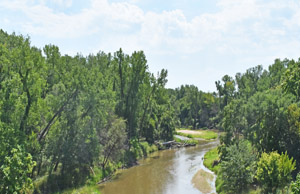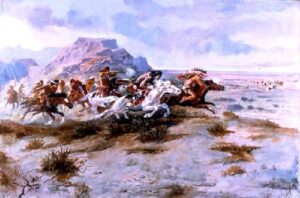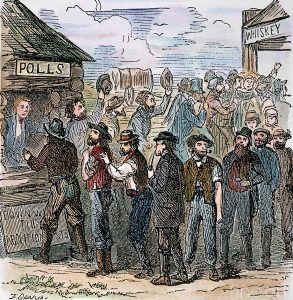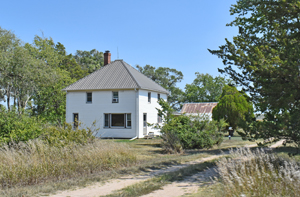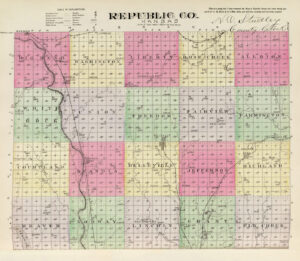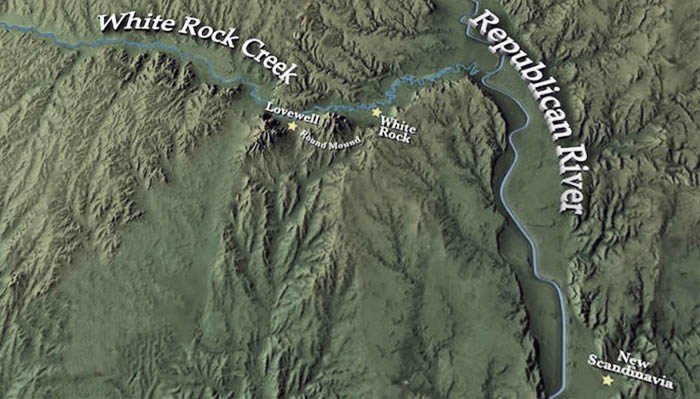White Rock was a small village in Republic County, Kansas. In its early days, it showed much promise, but the town is gone today.
Several attempts were made to settle the area, but it wasn’t until 1866 that Thomas Lovewell settled the town permanently. Because of its land qualities, it was considered a desirable location. It was located on the west side of the Republican River in White Rock Township. It was the first settlement in the county west of the Republican River. It was also on the leading emigrant route from Nebraska to the homestead territory.
The White Rock Valley had long been considered the most desirable location in Republic or Jewell Counties, and only the dread of Indians kept the settlers from it until this time.
With more people arriving in White Rock Township, a central meeting place was needed. A town company consisting of the Morlan Brothers, Tom Lovewell, Ed Laney, Chester Babcock, and G. W. Reynolds was soon put together. Lovewell and Babcock graciously gave up parts of their land to build a town. The company initially wanted to call the town “Pinhook,” but decided that “White Rock” was more appropriate, considering the nearby White Rock Bluffs and White Rock Creek.
The town published an ad in the Homesteaders Guide in 1869 to reach more people and increase its population. The ad read:
“White Rock City is located in the noted White Rock Valley in a well-timbered portion of the homestead county amid broad bottomlands and fertile uplands with good building rock and timber in abundance. Good opportunities are offered for farms and establishing all branches of trade and manufacturing.”
During the frontier days, more Indian outrages occurred in White Rock Valley than along any other stream in the area. About 25 people were either killed or carried away from the area. These outrages occurred year after year until 1870, when a permanent peace succeeded throughout the homestead region. Afterward, emigrants began to make their way up the peaceful valley of this beautiful stream, seeking homesteads on the adjacent land or in the counties farther to the west.
A post office was established on July 27, 1870, with Chester L. Babcock appointed postmaster.
White Rock was formally laid out in the spring of 1871, and school began to be taught that same year. At this point, the townsite contained only John Galbraith’s General Store.
White Rock Regular Baptist church was organized on March 1, 1872, with Reverend L. McDaniel at the pulpit. It was one of the oldest religious organizations in Republic County.
In 1873, there were three general stores, a sawmill, a corn mill, and a hotel.
The White Rock Independent, a weekly newspaper, was published at White Rock from 1877 to 1878 by Harlan Taylor. As its name indicated, it was independent in politics.
By 1878, White Rock was the most active trade center in Republic County. It served a populous and thriving farming region, and its streets were usually packed with customers. At that time, grain and livestock were its principal shipments, and a stagecoach ran daily to Scandia, delivering the mail to S.R. Morlan, the postmaster. The village also boasted a constable, a justice of the peace, two blacksmiths, two physicians, a wagonmaker, three general stores, two hotels, two butchers, a sawmill, a druggist, a boot and shoemaker, a harnessmaker, two carpenters, and a hardware and agricultural implements dealer, and a population of 50.
The White Rock Regular Baptists erected a church building in the summer of 1878. They shared the building with other religious denominations to worship.
That year, Republic County voters had the chance to approve $130,000 worth of bonds for the Kansas Pacific Railroad Company to build a railroad line that would have extended from Clifton in Washington County to the then-thriving towns of Seapo, Belleville, and White Rock. However, county voters defeated the bond issue by 1,126 to 850. Only two people voted in favor and 95 against in White Rock Township. The last residents of White Rock reported that city leaders believed their town was so prosperous that the railroad would be built through it, regardless of whether they approved the bonds to help fund the connection.
Later, it would be speculated that if White Rock City had voted “yes” on the bonds, it would have become the leading city in Republic County because of its committed establishments, flourishing water power, and blossoming businesses.
By the early 1880s, it was one of the county’s most prosperous and flourishing towns until the Central Branch Union Pacific Railroad was completed up the east side of the Republican River. However, even that misfortune did not destroy the town. It was still a business point, although its growth had stopped. It was then the depot of trade for a broad district, embracing the famous White Rock Valley and the adjacent portion of the Republican River. At that time, there were substantial and beautiful homes along the valley. White Rock Creek furnished water power for a greater part of the year for a substantial grist mill, which was furnished with steam power for steady work. The schools were in good condition, and the population was about 200.
After the Burlington and Missouri River Railroad surveyed a line through the area, there were high hopes that the town would resume its past prosperity if it were built.
However, that didn’t happen, and the town continued to decline. White Rock’s post office closed on September 15, 1900. By 1912, no businesses were left in the village, and only about 30 people resided there. The mail came by rural route from Courtland.
In 1926, the last of the old rock schoolhouse and the last building were cleared away when E.H. Smies bought the property. Today, nothing is left of the White Rock City site except for a memorial marker carved out of native white rock.
White Rock was located six miles north of Courtland and about 14 miles northwest of Belleville.
©Kathy Alexander/Legends of Kansas, updated September 2025.
Also See:
Extinct Towns in Republic County
Sources:
Blackmar, Frank W.; Kansas: A Cyclopedia of State History, Vol I; Standard Publishing Company, Chicago, IL 1912.
Clark, Terry; White Rock Township and White Rock City, Lost Kansas Communities, Chapman Center for Rural Studies, Kansas State University, Spring 2010.
Cutler, William G.; History of Kansas; A. T. Andreas, Chicago, IL, 1883.
Lovewell History
Savage, Isaac O.; A History of Republic County, Kansas; Jones & Chubbic, Beloit, Kansas, 1901.


